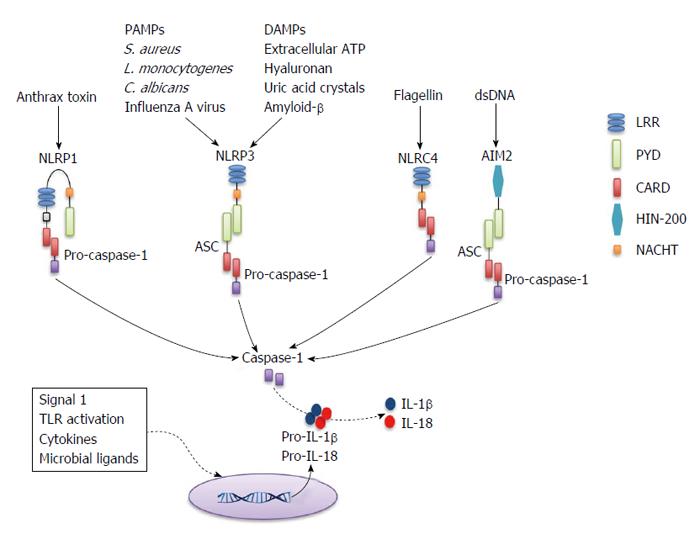Copyright
©The Author(s) 2016.
World J Hepatol. Feb 8, 2016; 8(4): 207-210
Published online Feb 8, 2016. doi: 10.4254/wjh.v8.i4.207
Published online Feb 8, 2016. doi: 10.4254/wjh.v8.i4.207
Figure 1 Basic representation of inflammasome activation.
Inflammasomes are formed after NLR or PYHIN family members recognize signals associated with tissue damage or infection. Receptors that have a CARD domain can recruit pro-caspase-1 directly (e.g., NLRC4), whereas those that contain a PYD domain (e.g., NLRP3 and AIM2) recruit pro-caspase-1 through the accessory protein ASC (which contains a PYD and a CARD). NLRP1 contains a CARD and can bypass the requirement for ASC, but also contains a PYD and its interaction with ASC enhances the activity of the NLRP1 inflammasome. CARD: Caspase-1 recruitment domain; PYD: Pyrin domain; ASC: Apoptosis-associated speck-like protein containing a CARD; LRR: Leucine rich repeat; HIN-200: Hematopoietic interferon-inducible nuclear antigen with 200 amino-acid repeat; PAMPs: Pathogen-associated molecular patterns; DAMPs: Damage-associated molecular patterns; AIM2: Absent in melanoma 2; dsDNA: Double-stranded DNA; IL: Interleukin; S. aureus: Staphylococcus aureus; L. monocytogenes: Listeria monocytogenes; C. albicans: Candida albicans; TLR: Toll-like receptor.
- Citation: González-Navajas JM. Inflammasome activation in decompensated liver cirrhosis. World J Hepatol 2016; 8(4): 207-210
- URL: https://www.wjgnet.com/1948-5182/full/v8/i4/207.htm
- DOI: https://dx.doi.org/10.4254/wjh.v8.i4.207









